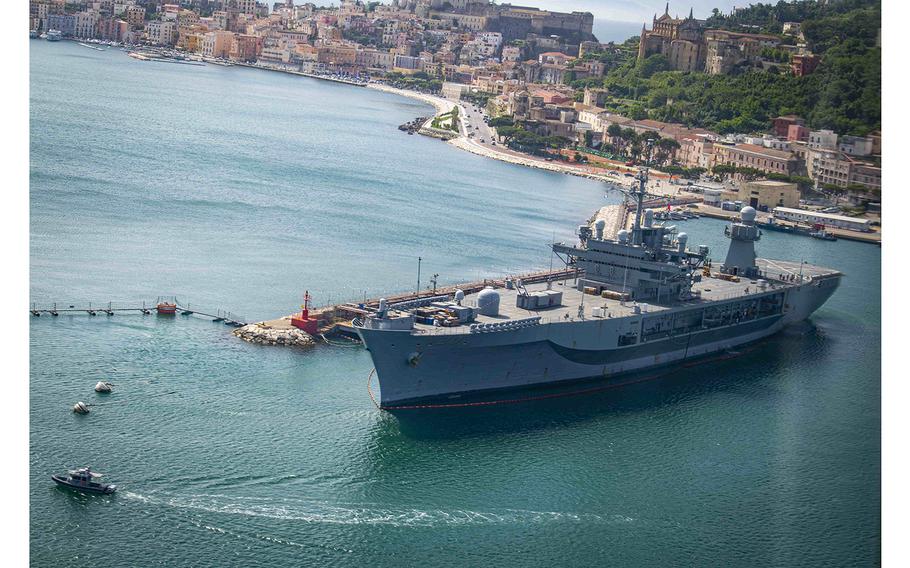
The Blue Ridge-class command and control ship USS Mount Whitney (LCC 20) sits in port in Gaeta, Italy, May 15, 2020. (Damon Grosvenor/U.S. Navy)
The Navy’s proposal to dump an amphibious command ship that it needs for keeping Russia in check is risky and ignores lessons from the war in Ukraine, according to analysts and a retired admiral who once led the service in Europe.
USS Mount Whitney, flagship of the Naples, Italy-based U.S. 6th Fleet, is slated for decommissioning in 2026, a move the Navy says in 2023 budget documents could save $179.7 million.
The plan doesn’t detail how the service would replace the ship’s maritime operations center, or MOC, and other capabilities, except to say the ship’s functions would be handled by ashore staff.
The MOC gives the Mount Whitney an incomparable range of applications in naval warfare, said retired Adm. James Foggo, who led U.S. Naval Forces Europe-Africa and Allied Joint Forces Command Naples from 2017 to 2020.
“It’s ludicrous to get rid of it,” said Foggo, now dean of the Center for Maritime Strategy of the Navy League. “We need that capability.”
Efforts to decommission the ship, which offers a strategic backup to ashore operations centers in Naples and Bahrain, run counter to the lessons learned from Russia’s failures in logistics and command and control in Ukraine, he said.
Transferring the Mount Whitney’s functions to a shore facility could impose significant limitations, said retired Capt. Bradley Martin, a former surface warfare officer.
Mount Whitney gives the U.S. the flexibility to move into international waters if another country, potentially Italy, objects to military decisions within its borders, Martin said.
“If we ever had to execute a full war, not having the command ships is something we would notice,” said Martin, now director of the National Security Supply Chain Institute for the Rand Corp. think tank.
For example, joint task force personnel embarked on the Mount Whitney in 2011 during Operation Odyssey Dawn in Libya, the international response following a brutal crackdown on Arab Spring protests by then-Libyan leader Muammar Gaddafi.
The ship traveled from its home port in Gaeta, Italy, about 12 miles offshore to conduct operations, Foggo said.
Foggo argues that no vessel in the current fleet could adequately replace Mount Whitney, which entered service in 1971, can embark up to 500 people and is one of two Blue Ridge-class amphibious command ships.
The other ship, USS Blue Ridge, serves a similar role as flagship of U.S. 7th Fleet, headquartered in Yokosuka, Japan. That ship, commissioned in 1970, is expected to be in service until 2039, according to the Navy.
Analysts say a vessel such as an amphibious assault ship or an amphibious transport dock could be modified to include Mount Whitney’s capabilities.
But those modifications would be extensive and expensive, said Jan van Tol, a retired Navy captain and senior fellow at the Center for Strategic and Budgetary Assessments, a Washington, D.C.-based think tank.
Those modifications also would remove the ship from its schedule of normal operational deployments, van Tol said.
The fate of the Mount Whitney has not been decided, so discussion about how it would be replaced or what would happen to its homeport in Gaeta is premature, Lt. Cmdr. Karl Schonberg, a Naval Forces Europe-Africa/U.S. 6th Fleet spokesman, said in a statement Thursday.
The ship supports U.S. 6th Fleet and Naval Striking and Support Forces NATO operations. By shortening lines of communication and offering a venue for leaders to meet, Mount Whitney offers the military an assortment of key assets, Capt. Daniel Prochazka, the ship’s commanding officer, said in a statement.
And in a conflict, a ship is more difficult to track, and less susceptible to physical, electronic and network attacks than a headquarters ashore, he added.
The Mount Whitney recently completed a $20.5 million overhaul that included installation of “the most up-to-date computer and communications system,” the service said in a statement Tuesday.
But supporters of the ship’s continuing role say the expenditure isn’t necessarily an indication that the Navy, which faces pressure to fund other programs, will abandon its proposal to decommission Mount Whitney.